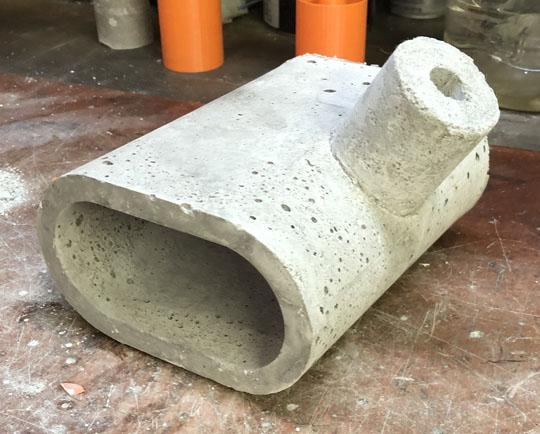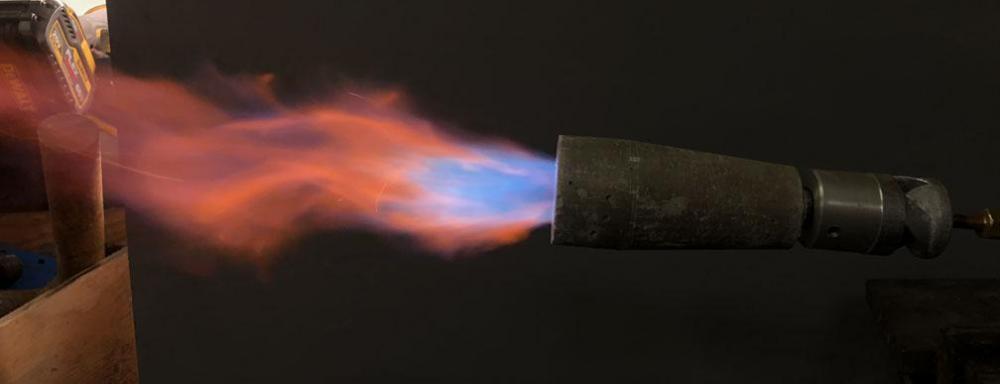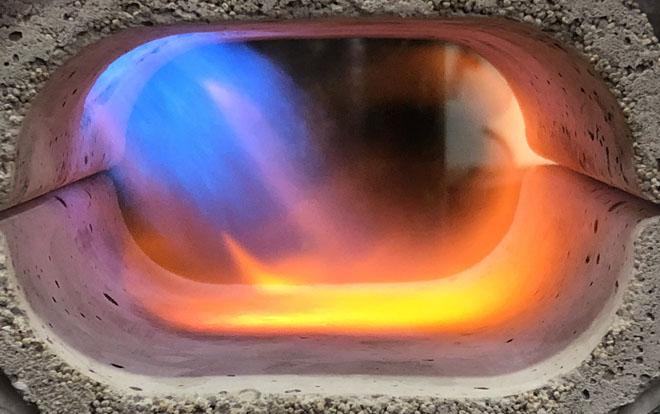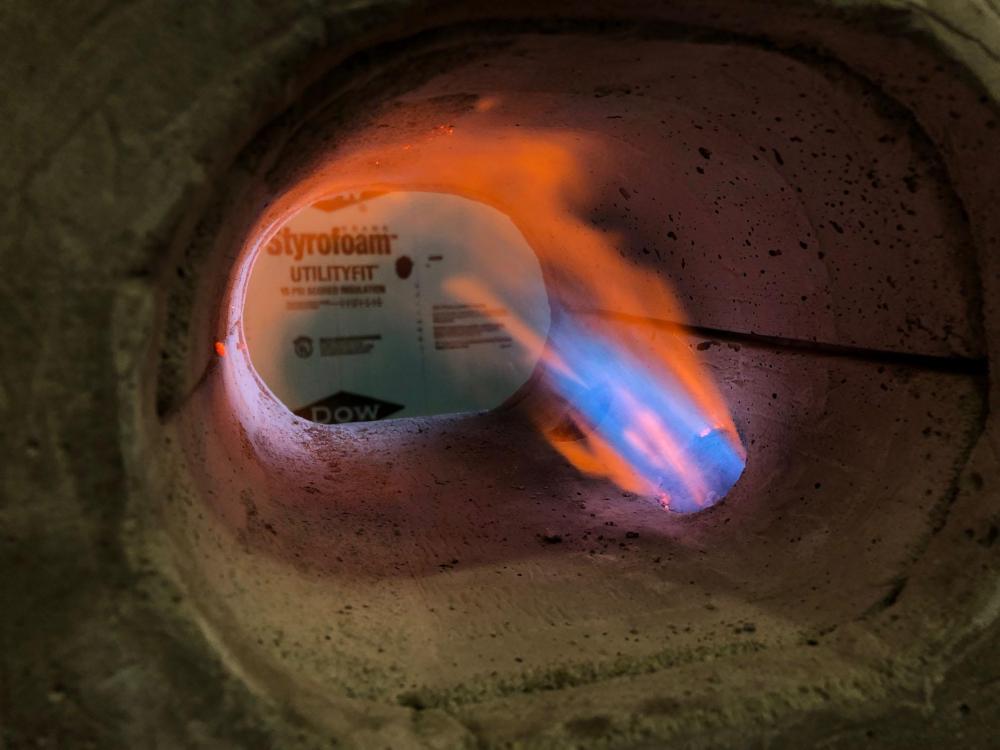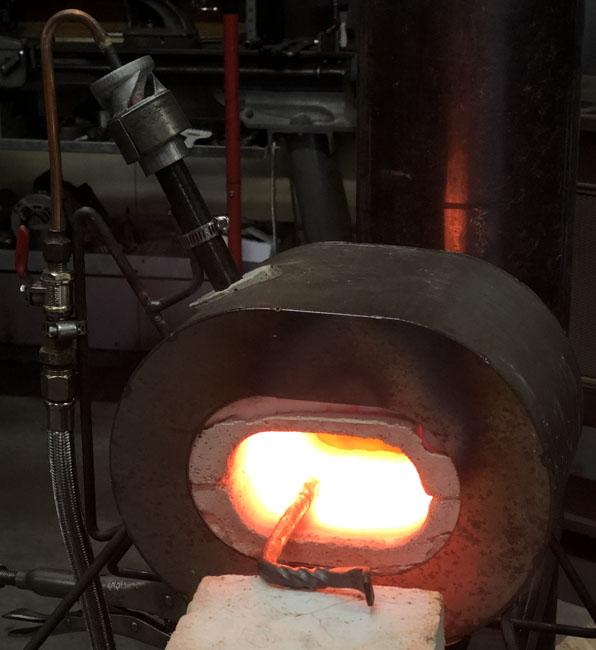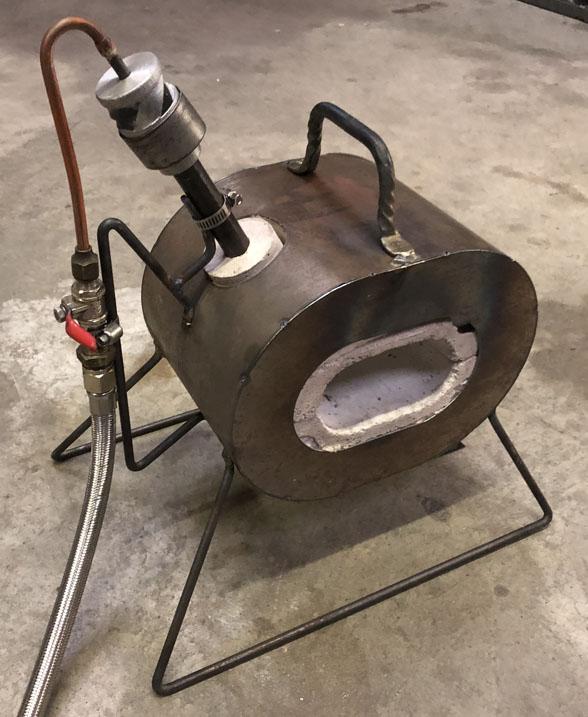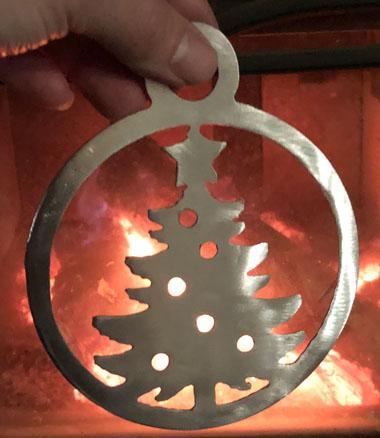-
Posts
616 -
Joined
-
Last visited
Content Type
Profiles
Forums
Articles
Gallery
Downloads
Events
Everything posted by Another FrankenBurner
-
If you are thinking 1/2" pipe, that is a nominal size. The actual ID is 0.622 which puts the 8x at 5 ish inches. The 1/2" Frosty T that I built did well with the 023 mig tip.
-
I thought about the telescoping pipe setup for mix tubes. Approximating a tapered mix tube with steps. Never actually tried it though. I am playing with smooth tapered mix tubes now. I look forward to your updates.
- 863 replies
-
If you are like me, welcome to an addiction. Even seemingly too small, otherwise scrap metal is a possibility. I avoid stock removal whenever possible. Any tool you can imagine, you can make. You are limited only by your own intellect and skill.
-
Don't feel bad, I suspect it is a common oversight on the first forge. Maybe not, maybe just me and you. I can't comment on the propane tanks as I don't use them for this. Their wall thickness is a bit heavy for me. My last forge was cased with sheet metal. I look forward to seeing your progress. Anything in particular you want to forge or more general hobby work?
-
I have not dabbled in the ribbon burners much yet. I am still playing with burner geometry in the simple burner to learn as much as I can. I am close to feeling satisfied with that and once I do, I look forward to adding to the list of variables with the ribbon burners. I will fully appreciate the lower volume everyone keeps bragging about. (Except for you and your singing forge) Shortening the mix tube is worth a shot. If it mixes properly in the plenum, your throughput should increase. I wonder if the fuel/air needs to be pushed down the restrictive tube to mingle well. Maybe that is why the 8-9 rule of thumb is around? It seems like the violent change in volume and direction would be good for mixing but every commercial unit I have seen, has the full length before the multiport. We'll see where the flame blade goes. I like the idea of one in a forge but they are a pain to get balanced. In the mix tube, the mix is spinning. It doesn't like to go long and narrow. I did get it to work and it looks great.
- 863 replies
-
Big possible mistake, your sizing. Your math is right if you were planning 1 inch of blanket only for a 6 inch internal diameter(ID) forge. An 8 inch pipe, minus 4" for blanket(2" per side), minus 1" for kastolite(1/2" per side) yields an ID of 3 inches. I am guessing you subtracted the 2 inches of blanket from the 8 inch pipe for 6 inches or did you square the 3 inch diameter instead of the radius? Two inches of blanket and 1/2 inch of kastolite for the 3 inch ID would be ~71 in³ at 10 inch length or ~85 in³ at 12 inches. If you were expecting 3 inch ID, great. One 3/4" burner might be too much, maybe not. If you go to 12 inch length, your forge will be fairly small and long which may hinder the burner performance. You might think about 2 smaller burners or a shorter forge. I had a forge at 3 1/2 inches ID by 12 inches length with a 3/4" burner. It worked well. Made out of a refrigerant cylinder based on Ron Reil's website. If you were expecting a 6 inch ID, you need an 11 inch case. The larger disposable helium cylinders and 20lb propane cylinders are around 12 inches. As to the kastolite on the bottom or all the way around, that is personal preference. Just the bottom will be less mass in the forge which will heat up faster and possibly to a little higher temperatures but the walls and ceiling will be fragile to piece bumps. If you are clumsy with hot metal, armor the walls and ceiling with kastolite. It will take a little longer to come to temperature and maybe not get to as high a temperature but it beats poking into the blanket. If you are only half clumsy, the kastolite can be thinner. Experiments are great. Sounds like you do your homework, you'll have a hot forge in no time.
-
Going back a ways 671. I am playing with blanket and kastolite so often that I had to go back to that post to know what I was talking about. The originals are still around. I can't say that about the firebricks. They all turned to rubble. They are great. I have had them yellow on one side and I am able to briefly touch the backsides to move them. One ham handed day I knocked one off the front porch and it impacted the floor while orange. He is still around and shows no evidence of the abuse. The matrikote peeled off of them but it was applied before I knew to butter them up. I haven't reapplied it yet. I will be making baffle walls for the mini forges with the same method. We like the size 4.5" x 4.5" x 2". Kind of a half brick. We will eventually have a bunch of them to pile up and point burners at for the odd jobs.
-
I also lack the dexterity for left handed burr work. Good idea though. I am going to give it a try anyway. Makes me want for a counterclockwise rotary tool. I was worried about bringing it in the house on my clothes as it tends to get everywhere. I had not thought about cleaning out my hair. Thank you for that tip.
-
I just finished up a guillotine this weekend. I took the simple tool used by Glen (GS Tongs) and added Frosty's idea of remoting the dies from the hardy hole to get them both at the edge of the anvil and over the trunk. It is a wonderful tool. Back when I was tougher than loud noises and high velocity shards I damaged my hearing and had metal extracted from my eye. I was educated. I am now a safety dork and I am no longer tougher than even airborne dust. So there I was, in my leather apron, electronic ear muffs, respirator and safety glasses, while using a rotary burr, I managed to shoot a sliver into my eye. It penetrated, oh goody. I used a strong magnet to get it out but it still didn't feel right so I ended up going to the eye doc again. Luckily all was well and it only added $50 to the cost of this project. I still have depth perception, yay. I will be wearing goggles or a shield when using burrs from now on.
-
Fresh kast o lite burn off gives the greatest contrast for fun fire pictures. Another mini forge startup: Here is another experimental burner: Here is an inner with nozzle for the next mini forge experiment:
- 863 replies
-

Copper with sweat joints for propane to forge
Another FrankenBurner replied to RToons's topic in Gas Forges
Copper is acceptable for propane in International Fuel Gas Code. The "sweat" joints are required to be constructed with an alloy with a higher melt temperature than 1000°F. This rules out low temperature solders typically used for home plumbing. I construct my forge fuel lines with mainly silver brazed 1/4" soft copper lines and brass fittings. Inexpensive, functional, minimal, it looks good.- 6 replies
-
- copper propane delivery
- sweating copper
-
(and 1 more)
Tagged with:
-
Well that's good to know. I don't want to use mig torch nozzles as retention nozzles. I am trying to figure out how to fire a high alumina ceramic with the tools I have. Ron Reil has a box of old prototype burners up in his loft which, of course, I had to dig through and investigate. In this box was a copper burner that looks like a predecessor to the Hybrid burner. It has a mig tip nozzle as a flame retention nozzle. He said he could not recall who, but that someone had sent it to him years ago. Based on the Nanomongo burner on his webpage, which he credited to you, I wondered if this mig nozzle burner was also something of yours.
-
Here was one of my nozzle experiments a while back. We call it the flame blade. The intent was to stretch the heat source along a large length of the wall and have a short length flame. The geometry is critical on these guys and must be balanced with the burner. As I am still tinkering with burners, I had set this one on the back burner until I eventually maybe finalize my burner design so that I can then produce one of these which matches that burner. Here is the complete 1/2 inch burner still in plastic and plaster: Here is a shot of the narrow channel of the retention nozzle: Here is the flame it produces: This was after several failure experiments to get the geometry all balanced:
- 863 replies
-
I don't currently. We have built 6 forges with cast in refractory retention nozzles with kast o lite. Several of them have many hours of operation and show no problems. No longer having a steel nozzle is a great thing. Every time I used to start up my forge, I would hear little popping noises as the scale would pop off the always thinning stainless nozzle. The refractory nozzle also gets the mix tube a little further back from the inner forge and conducts less heat to the mix tube. Kast o lite is chunky clunky but it works well. It takes the heat and it is tough stuff. Ribbon burners could be made out of it but it sure would be nice to have something finer for that work. It took a bit of experimenting to get the kast o lite/water ratio as good as we can get it. It is much drier than we started out. It ends up smooth if in a form, even at the drier mixes. I have been dabbling in high alumina ceramics and the bentonite/zircopax concoctions but not enough yet to have any conclusions. If I could get either of them right, it would be nice. My TIG welding torch has a pink high alumina ceramic nozzle which is thin walled, thermally stable, and seemingly indestructible. I would like to figure that out.
-
If you hover your mouse over the name of the person on the left side of their post, it will open a small pop up menu showing profile stats. In that menu, at the bottom left is an envelope icon and the word message. Click that and it will open the private message screen. Alternatively, you can click on their name to view their profile which also has a Message button. Another way, at the top right of any page here, you will have an envelope icon. Click that and a menu opens. In that menu is a Compose New button. You will have to type the name of the person you want to message, if you go this route.
- 863 replies
-
My experimental nozzle prototypes start their life as plaster of paris to avoid wasting refractory on total failures. The plaster nozzles present the same brilliant orange display the first firing. Somewhere in my readings, it was referred to as calcination.
-
I had posted a picture in the 3D printed thread which demonstrates this. It shows fresh kast o lite cooking. It is quite obviously different from the flame. It goes away pretty quickly during the first full firing. Here is a relink to that photo:
-
I was mainly joking around, not my strong suit but I keep trying. What you said makes sense though. I have played with heating the mix(not liquid fuel) but always fought the flame propagation velocity being so fast that it flashed back. In the case of liquid with a phase change, I bet there is enough refrigeration of the mix to prevent this problem. It's pretty clever. I can think of a few ways to pull that off but I would think controlling the amount of preheating would be important and that seems like a balancing act. Fun thoughts. I probably won't dabble in that. Seems like a complication not worth the effort on low output burners. As to running the numbers on the BTU content of the fuel, I don't try to be that specific. A rough idea, sure, but there are too many variables for me to accurately calculate anything like that for real. What I was meaning was that any two burners comparably burning the same quantity of fuel are outputting similar BTU's regardless of orifice size, fuel pressure, mix tube size, etc.
- 863 replies
-
What he said. Your latest burner looks like a great burner. On the easier to build end of the spectrum which is a great thing. What was your reasoning for placing the air inlets that far from the end of the pipe?
-
It sounds like fun but then the flame propagation velocity increases. This leads to pumping up the output velocity which leads to a powered air supply which leads to a redesigned mixing chamber which leads to... I can see the headlines now, "A man was killed in his garage early Sunday morning when his experimental turbine forge exploded." I will put some thought into pulling this off.
- 863 replies
-
Thank you all. It is encouraging. The forge turned out very nice. We have some changes in mind for the next ones. As to marketing them, I certainly won't rule it out. I would like to be a source for a high quality forge. A lot would have to go into that. I worry about liability(as much as I hate that word). I am not sure about shipping fired refractory. Also a lot goes into these between all the printing, the cast curing times, the kiln firing the refractory, investment casting the burner head, making the orifice assemblies, cutting out and welding the shell and the material costs. At the end of it, it's a mini forge. I don't know that I could provide them at a decent price and for similar labor/material costs, a larger forge could be had. As a hobbyist forge, this forge is great. I worked out of a Freon tank mini forge for a couple of years after building one based on Ron Reil's website. It has about a 4 inch cylinder interior at 12 inches long. This gives about 1.5 inches width of actual flat floor in a forge which is too long and has a hot spot right in the middle. Typically I was heating 5 extra inches of bar closer to where I want to hold it, just so I could get into this hot spot. This new mini forge has 3.5 inches of flat floor and it is hot front to back. It uses a smaller burner and it is hotter. Less fuel and more capable. I can't say enough good things about it. I am a fan of the smallest forge to get the job done though. The burner was scaled down for this forge. It ended up taking a 0.8mm printer nozzle drilled out to 0.035 inches for the orifice which means this little burner can really put out heat. I was quite surprised it was happy with an orifice this large. I think it has to do with the short length of the mix tube and the shape of the retention nozzle which is cast directly in the forge lining. I'm not sure but we were all smiles once we realized it was a mighty mouse. I am still tinkering with burners though. Playing with nozzle shape, I now have a 3/8" burner which likes the 1.2mm(0.047") printer nozzle. I am still tinkering with it but it is a tiny burner putting out major BTU's. I am now thinking about burners in terms of their output instead of their nominal throat size. My half inch burner has a 1mm(0.039") printer nozzle orifice and I think that it is a contender with some of the 3/4" burners. This new 3/8" burner is running bigger than that. It makes me wonder if I scale it down to a point where it is happy with the 1mm orifice, could I have a baby burner that outputs similar BTU's as a 3/4" burner? This is getting ahead of myself as I have not fully tested this new burner through all of the pressure ranges up against a forge. It is still plastic and plaster. I am just excited at the idea of a smaller burner. Tinkering is fun.
- 863 replies
-
My father and I made a 3/8" burner mini forge for the brother for Christmas. An introduction to blacksmithing to start his addiction. A man can't have too many vices. We are now both jealous and making a couple more. The 3D printer was responsible for a lot here. The burner head pattern, the mold for the refractory nozzle and the inner forge forms were all printed. The forge interior is an oval created by splitting a 2 inch circle by 2 inches. It is 6 inches front to back. (~43 in³) It gives good floor space for how small the forge is. It is a very capable forge. The burner ended up outputting much more than expected and could supply more forge than this. This little dragon is hot at lower pressures and is happy with less fuel. Here it is sans baffle walls and at the low end of the regulator:
- 863 replies
-
A shorter mix tube is less resistance. I am not sure about slower, I suspect the opposite, but what I have seen is blunt, bushy flames. If pushed too short, the flame will show under mixing symptoms
-
I built a 1/2" Frosty T burner with the 023 mig tip. It worked well. If you are talking about a 1 gallon paint can (6.5d x 7.5h ish), I expect the 1/2" burner would be much more than needed. Especially since you just want to get to heat treat temperatures. A 3/8" burner might be too much. I suspect a propane torch would be plenty.


